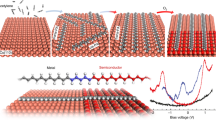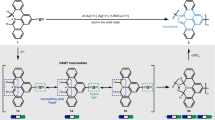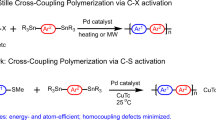Abstract
Here we demonstrate the synthesis of cyclic polyacetylene (c-PA), or [∞]annulene, via homogeneous tungsten-catalysed polymerization of acetylene. Unique to the cyclic structure and evidence for its topology, the c-PA contains >99% trans double bonds, even when synthesized at −94 °C. High activity with low catalyst loadings allows for the synthesis of temporarily soluble c-PA, thus opening the opportunity to derivatize the polymer in solution. Absolute evidence for the cyclic topology comes from atomic force microscopy images of bottlebrush derivatives generated from soluble c-PA. Now available in its cyclic form, initial characterization studies are presented to elucidate the topological differences compared with traditionally synthesized linear polyacetylene. One advantage to the synthesis of c-PA is the direct synthesis of the trans–transoid isomer. Low defect concentrations, low soliton concentration, and relatively high conjugation lengths are characteristics of c-PA. Efficient catalysis permits the rapid synthesis of lustrous flexible thin films of c-PA, and when doped with I2, they are highly conductive (398 (±76) Ω−1 cm−1).

This is a preview of subscription content, access via your institution
Access options
Access Nature and 54 other Nature Portfolio journals
Get Nature+, our best-value online-access subscription
$29.99 / 30 days
cancel any time
Subscribe to this journal
Receive 12 print issues and online access
$259.00 per year
only $21.58 per issue
Buy this article
- Purchase on Springer Link
- Instant access to full article PDF
Prices may be subject to local taxes which are calculated during checkout





Similar content being viewed by others
Data availability
All relevant data are provided in the figures, table and Supplementary Information.
Change history
14 September 2021
A Correction to this paper has been published: https://doi.org/10.1038/s41557-021-00809-9
References
Kekulé, A. Sur la constitution des substances aromatiques. B. Mens. Soc. Chim. Paris 3, 98–110 (1865).
Kekulé, A. Ueber einige condensationsprodukte des aldehyds. Ann. Chem. Pharm. 162, 77–124 (1872).
Lonsdale, K. The structure of the benzene ring in C6(CH3)6. Proc. R. Soc. Lond. A 123, 494–515 (1929).
Hückel, E. Quantentheoretische beiträge zum benzolproblem i. Die elektronenkonfiguration des benzols und verwandter verbindungen. Z. Phys. 70, 204–286 (1931).
Rickhaus, M. et al. Global aromaticity at the nanoscale. Nat. Chem. 12, 236–241 (2020).
Ni, Y. et al. 3D global aromaticity in a fully conjugated diradicaloid cage at different oxidation states. Nat. Chem. 12, 242–248 (2020).
Sondheimer, F. & Wolovsky, R. The synthesis of cycloöctadecanonaene, a new aromatic system. Tetrahedron Lett. 1, 3–6 (1959).
Sondheimer, F. & Gaoni, Y. Unsaturated macrocyclic compounds. XV. Ccyclotetradecaheptaene. J. Am. Chem. Soc. 82, 5765–5766 (1960).
Kertesz, M., Choi, C. H. & Yang, S. Conjugated polymers and aromaticity. Chem. Rev. 105, 3448–3481 (2005).
Yoshizawa, K., Kato, T. & Yamabe, T. Electron correlation effects and possible D6h structures in large cyclic polyenes. J. Phys. Chem. 100, 5697–5701 (1996).
Choi, C. H. & Kertesz, M. Bond length alternation and aromaticity in large annulenes. J. Chem. Phys. 108, 6681–6688 (1998).
Natta, G., Mazzanti, G. & Corradini, P. Atti Accad. Naz. Lincei Cl. Sci. Fis. Mat. Nat. Rend. 25, 3–12 (1958).
Chien, J. C. W. Polyacetylene: Chemistry, Physics, and Material Science (Academic, 1984).
Feast, W. J., Tsibouklis, J., Pouwer, K. L., Groenendaal, L. & Meijer, E. W. Synthesis, processing and material properties of conjugated polymers. Polymer 37, 5017–5047 (1996).
Hudson, B. S. Polyacetylene: myth and reality. Materials 11, 1–21 (2018).
Berets, D. J. & Smith, D. S. Electrical properties of linear polyacetylene. Trans. Faraday Soc. 64, 823–828 (1968).
Shirakawa, H. & Ikeda, S. Infrared spectra of poly(acetylene). Polym. J. 2, 231–244 (1971).
Chiang, C. K. et al. Synthesis of highly conducting films of derivatives of polyacetylene, (CH)x. J. Am. Chem. Soc. 100, 1013–1015 (1978).
Skotheim, T. A. & Reynolds, J. Handbook of Conducting Polymers (CRC, 2007).
Liu, J. Z., Lam, J. W. Y. & Tang, B. Z. Acetylenic polymers: syntheses, structures and functions. Chem. Rev. 109, 5799–5867 (2009).
Nadif, S. S. et al. Introducing “ynene” metathesis: ring-expansion metathesis polymerization leads to highly cis and syndiotactic cyclic polymers of norbornene. J. Am. Chem. Soc. 138, 6408–6411 (2016).
Gonsales, S. A. et al. Highly tactic cyclic polynorbornene: stereoselective ring expansion metathesis polymerization of norbornene catalyzed by a new tethered tungsten-alkylidene catalyst. J. Am. Chem. Soc. 138, 4996–4999 (2016).
Xia, Y. et al. Ring-expansion metathesis polymerization: catalyst-dependent polymerization profiles. J. Am. Chem. Soc. 131, 2670–2677 (2009).
Bielawski, C. W., Benitez, D. & Grubbs, R. H. An “endless” route to cyclic polymers. Science 297, 2041–2044 (2002).
Chang, Y. A. & Waymouth, R. M. Recent progress on the synthesis of cyclic polymers via ring-expansion strategies. J. Polym. Sci. Pol. Chem 55, 2892–2902 (2017).
Tezuka, Y. Progress of Cyclic Polymers in Syntheses, Properties and Functions (World Scientific, 2013).
McGowan, K. P., O’Reilly, M. E., Ghiviriga, I., Abboud, K. A. & Veige, A. S. Compelling mechanistic data and identification of the active species in tungsten-catalyzed alkyne polymerizations: conversion of a trianionic pincer into a new tetraanionic pincer-type ligand. Chem. Sci. 4, 1145–1155 (2013).
Sarkar, S. et al. An OCO3− trianionic pincer tungsten(VI) alkylidyne: rational design of a highly active alkyne polymerization catalyst. J. Am. Chem. Soc. 134, 4509–4512 (2012).
Roland, C. D., Li, H., Abboud, K. A., Wagener, K. B. & Veige, A. S. Cyclic polymers from alkynes. Nat. Chem. 8, 791–796 (2016).
Pal, D., Miao, Z. H., Garrison, J. B., Veige, A. S. & Sumerlin, B. S. Ultrahigh molecular weight macrocyclic bottlebrushes via post-polymerization modification of a cyclic polymer. Macromolecules 53, 9717–9724 (2020).
Miao, Z. H., Kubo, T., Pal, D., Sumerlin, B. S. & Veige, A. S. pH-responsive water-soluble cyclic polymer. Macromolecules 52, 6260–6265 (2019).
Niu, W. J. et al. Polypropylene: now available without chain ends. Chem 5, 237–244 (2019).
Roland, C. D., Zhang, T., VenkatRamani, S., Ghiviriga, I. & Veige, A. S. A catalytically relevant intermediate in the synthesis of cyclic polymers from alkynes. Chem. Commun. 55, 13697–13700 (2019).
Miao, Z. H. et al. Cyclic poly(4-methyl-1-pentene): efficient catalytic synthesis of a transparent cyclic polymer. Macromolecules 53, 7774–7782 (2020).
Baker, G. L., Shelburne, J. A. & Bates, F. S. Preparation of low-spin trans-polyacetylene. J. Am. Chem. Soc. 108, 7377–7380 (1986).
Ito, T., Shirakawa, H. & Ikeda, S. Simultaneous polymerization and formation of polyacetylene film on surface of concentrated soluble Ziegler-type catalyst solution. J. Polym. Sci. Pol. Chem 12, 11–20 (1974).
Oth, J. F. M. Conformational mobility and fast bond shift in the annulenes. Pure Appl. Chem. 25, 573–622 (1971).
Michel, C. S. et al. Tunneling by 16 carbons: planar bond shifting in [16]annulene. J. Am. Chem. Soc. 141, 5286–5293 (2019).
Harada, I., Tasumi, M., Shirakawa, H. & Ikeda, S. Raman spectra of polyacetylene and highly conducting iodine-doped polyacetylene. Chem. Lett. 7, 1411–1414 (1978).
Schugerl, F. B. & Kuzmany, H. Optical modes of trans-polyacetylene. J. Chem. Phys. 74, 953–958 (1981).
Lichtmann, L. S., Fitchen, D. B. & Temkin, H. Resonant Raman spectroscopy of conducting organic polymers. (CH)x and an oriented analog. Synth. Met. 1, 139–149 (1980).
Mulazzi, E., Brivio, G. P., Faulques, E. & Lefrant, S. Experimental and theoretical Raman results in trans polyacetylene. Solid State Commun. 46, 851–855 (1983).
Ehrenfreund, E., Vardeny, Z., Brafman, O. & Horovitz, B. Amplitude and phase modes in trans-polyacetylene: resonant Raman scattering and induced infrared activity. Phys. Rev. B 36, 1535–1553 (1987).
Kuzmany, H., Imhoff, E. A., Fitchen, D. B. & Sarhangi, A. Frank–Condon approach for optical-absorption and resonance Raman scattering in trans-polyacetylene. Phys. Rev. B 26, 7109–7112 (1982).
Heller, E. J., Yang, Y. & Kocia, L. Raman scattering in carbon nanosystems: solving polyacetylene. ACS Cent. Sci. 1, 40–49 (2015).
Chance, R. R., Schaffer, H., Knoll, K., Schrock, R. & Silbey, R. Linear optical-properties of a series of linear polyenes—implications for polyacetylene. Synth. Met. 49, 271–280 (1992).
Schaffer, H. E., Chance, R. R., Silbey, R. J., Knoll, K. & Schrock, R. R. Conjugation length dependence of Raman scattering in a series of linear polyenes—implications for polyacetylene. J. Chem. Phys. 94, 4161–4170 (1991).
Schaffer, H., Chance, R., Knoll, K., Schrock, R. & Silbey, R. Linear optical properties of a series of polyacetylene oligomers. In Conjugated Polymeric Materials: Opportunities in Electronics, Optoelectronics, and Molecular Electronics (eds Brédas, J. & Chance, R.) 365–376 (Springer, 1990).
Brivio, G. P. & Mulazzi, E. Theoretical analysis of absorption and resonant Raman scattering spectra of trans-(CH)x. Phys. Rev. B 30, 876–882 (1984).
Chen, Z. X. et al. Mechanochemical unzipping of insulating polyladderene to semiconducting polyacetylene. Science 357, 475–478 (2017).
Kang, C., Jung, K., Ahn, S. & Choi, T. L. Controlled cyclopolymerization of 1,5-hexadiynes to give narrow band gap conjugated polyacetylenes containing highly strained cyclobutenes. J. Am. Chem. Soc. 142, 17140–17146 (2020).
Gorman, C. B., Ginsburg, E. J. & Grubbs, R. H. Soluble, highly conjugated derivatives of polyacetylene from the ring-opening metathesis polymerization of monosubstituted cyclooctatetraenes—synthesis and the relationship between polymer structure and physical properties. J. Am. Chem. Soc. 115, 1397–1409 (1993).
Scherman, O. A., Rutenberg, I. M. & Grubbs, R. H. Direct synthesis of soluble, end-functionalized polyenes and polyacetylene block copolymers. J. Am. Chem. Soc. 125, 8515–8522 (2003).
Knoll, K. & Schrock, R. R. Preparation of tert-butyl-capped polyenes containing up to 15 double bonds. J. Am. Chem. Soc. 111, 7989–8004 (1989).
Eckhardt, H. On the optical-properties of trans-polyacetylene. J. Chem. Phys. 79, 2085–2086 (1983).
Sebelik, V. et al. Spectroscopy and excited state dynamics of nearly infinite polyenes. Phys. Chem. Chem. Phys. 22, 17867–17879 (2020).
Fincher, C. R. et al. Electronic-structure of polyacetylene—optical and infrared studies of undoped semiconducting (CH)x and heavily doped metallic (CH)x. Phys. Rev. B 20, 1589–1602 (1979).
Leal, J. F. P. et al. Properties of charged defects on unidimensional polymers. J. Comput. Theor. Nanosci. 8, 541–549 (2011).
Maricq, M. M., Waugh, J. S., Macdiarmid, A. G., Shirakawa, H. & Heeger, A. J. Carbon-13 nuclear magnetic resonance of cis- and trans-polyacetylenes. J. Am. Chem. Soc. 100, 7729–7730 (1978).
Haberkorn, H., Naarmann, H., Penzien, K., Schlag, J. & Simak, P. Structure and conductivity of poly(acetylene). Synth. Met. 5, 51–71 (1982).
Dubroca, T. et al. A quasi-optical and corrugated waveguide microwave transmission system for simultaneous dynamic nuclear polarization NMR on two separate 14.1 T spectrometers. J. Magn. Reson. 289, 35–44 (2018).
Knoll, K., Krouse, S. A. & Schrock, R. R. Preparation and isolation of polyenes containing up to 15 double bonds. J. Am. Chem. Soc. 110, 4424–4425 (1988).
Gibson, H. W., Kaplan, S., Mosher, R. A., Prest, W. M. & Weagley, R. J. Isomerization of polyacetylene films of the Shirakawa type—spectroscopy and kinetics. J. Am. Chem. Soc. 108, 6843–6851 (1986).
Goldberg, I. B., Crowe, H. R., Newman, P. R., Heeger, A. J. & Macdiarmid, A. G. Electron-spin resonance of polyacetylene and AsF5-doped polyacetylene. J. Chem. Phys. 70, 1132–1136 (1979).
Weinberger, B. R., Kaufer, J., Heeger, A. J., Pron, A. & Macdiarmid, A. G. Magnetic susceptibility of doped polyacetylene. Phys. Rev. B 20, 223–230 (1979).
Shirakawa, H., Ito, T. & Ikeda, S. Electrical properties of polyacetylene with various cis–trans compositions. Makromol. Chem. 179, 1565–1573 (1978).
Bernier, P. et al. Magnetic properties of cis- and trans-polyacetylene as studied by electron spin resonance. Polym. J. 13, 201–207 (1981).
Bernier, P. et al. Electronic properties of non-doped and doped polyacetylene films studied by ESR. J. Phys. Lett. 40, L297–L301 (1979).
Heeger, A. J. Charge-transfer in conducting polymers. Striving toward intrinsic properties. Faraday Discuss. 88, 203–211 (1989).
Pfeiffer, R. S., Yoder, G. & Chen, A. B. Ground state and excitations in polyacetylene chains. Phys. Rev. B 54, 1735–1740 (1996).
Basescu, N. et al. High electrical conductivity in doped polyacetylene. Nature 327, 403–405 (1987).
Tsukamoto, J. & Takahashi, A. Synthesis and electrical properties of polyacetylene yielding conductivity of 105 S/cm. Synth. Met. 41, 7–12 (1991).
Doering, Wv. E. & Sarma, K. Stabilization energy of polyenyl radicals: all-trans-nonatetraenyl radical by thermal rearrangement of a semirigid {4-1-2} heptaene. Model for thermal lability of beta-carotene. J. Am. Chem. Soc. 114, 6037–6043 (1992).
Bernardi, B. F., Garavelli, M. & Olucci, M. Trans cis isomerization in long linear polyenes as beta-carotene models: a comparative CAS-PT2 and DFT study. Mol. Phys. 92, 359–364 (1997).
Acknowledgements
A portion of this work was performed in the McKnight Brain Institute at the National High Magnetic Field Laboratory’s Advanced Magnetic Resonance Imaging and Spectroscopy (AMRIS) Facility. The assistance from A. Mehta in the collection of the solid-state NMR data is gratefully acknowledged. D. Wei and J. Huang are acknowledged for assisting in the acquisition of diffuse-reflectance UV–vis spectra. This material is based on work supported by the National Science Foundation CHE-1808234. The solid-state NMR study was supported by National Science Foundation Cooperative Agreement DMR-1644779 and the State of Florida. The NMR spectrometer used to acquire the solid-state NMR spectra was funded, in part, by National Institutes of Health award S10RR031637. The MAS-DNP instrument at NHMFL is supported by the NIH P41 GM122698 and NIH S10 OD018519 grants.
Author information
Authors and Affiliations
Contributions
Z.M. synthesized c-PA and l-PA in all forms, characterized c-PA and l-PA with IR, Raman, CP-MAS 13C NMR and EPR, performed the cryogenic UV–vis monitoring the synthesis of temporarily soluble c-PA, synthesized and obtained the AFM images of cyclic bottlebrushes from temporarily soluble c-PA, and studied the conductivities of c-PA before and after doping with I2. S.A.G. synthesized c-PA, characterized c-PA with IR and studied its conductivity. C.R.B. studied the CP-MAS 13C NMR of c-PA and l-PA. C.E. provided data analysis and preliminary computational modelling of 13C NMR data. F.M.-V. performed MAS-DNP 13C NMR experiments. The manuscript was written with contributions from all authors. All authors have given approval to the final version of the manuscript. A.S.V. and B.S.S. directed the research.
Corresponding authors
Ethics declarations
Competing interests
The authors and UF Research Foundation Inc. have filed patents related to this subject matter. PCT Patent Application No. PCT/US21/17916.
Additional information
Peer review information Nature Chemistry thanks the reviewers for their contribution to the peer review of this work.
Publisher’s note Springer Nature remains neutral with regard to jurisdictional claims in published maps and institutional affiliations.
Supplementary information
Supplementary Information
Supplementary Figs. 1–25, Discussion and Tables 1–6.
Supplementary Video 1
This video depicts the colour change during the polymerization of dilute acetylene THF solution with catalyst 1.
Rights and permissions
About this article
Cite this article
Miao, Z., Gonsales, S.A., Ehm, C. et al. Cyclic polyacetylene. Nat. Chem. 13, 792–799 (2021). https://doi.org/10.1038/s41557-021-00713-2
Received:
Accepted:
Published:
Issue Date:
DOI: https://doi.org/10.1038/s41557-021-00713-2
This article is cited by
-
Proton-triggered topological transformation in superbase-mediated selective polymerization enables access to ultrahigh-molar-mass cyclic polymers
Nature Chemistry (2024)
-
Recyclable cyclic bio-based acrylic polymer via pairwise monomer enchainment by a trifunctional Lewis pair
Nature Chemistry (2023)
-
Polysilyne chains bridged with beryllium lead to flat 2D Dirac materials
Scientific Reports (2023)
-
Scalable and continuous access to pure cyclic polymers enabled by ‘quarantined’ heterogeneous catalysts
Nature Chemistry (2022)



